|
|
|
Sort Order |
|
|
|
Items / Page
|
|
|
|
|
|
|
| Srl | Item |
| 1 |
ID:
133121
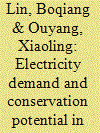

|
|
|
|
|
| Publication |
2014.
|
| Summary/Abstract |
As the high energy-consuming manufacturing industry, electricity consumption of nonmetallic mineral products in China accounted for 7.93% of industrial, 5.84% of national and 1.33% of global electricity consumption in 2010. This study attempts to specify the determinants of sectoral electricity demand, forecast future electricity consumption by creating a model using the Johansen cointegration methodology and estimate the sectoral electricity conservation potential. Results indicate that GDP per capita is the leading force explaining the sectoral electricity consumption increase, while value-added per worker, R&D intensity and electricity price are the main factors contributing to the sectoral electricity consumption decrease. Results demonstrate that sectoral electricity consumption in 2020 will be 369.79-464.83 billion kWh under the low-growth scenario and 530.14-666.39 billion kWh under the high-growth scenario. Moreover, under the low-growth scenario, the sectoral electricity conservation potential in 2020 will be 33.72-95.03 billion kWh, accounting for 0.45-1.26% of China's total electricity demand in 2020; under the high-growth scenario, the sectoral electricity conservation potential in 2020 will be 48.34-136.24 billion kWh, accounting for 0.26-0.74% of world's total electricity consumption in 2010 respectively. Finally, we provide some policy recommendations for encouraging energy conservation in China's nonmetallic mineral products industry.
|
|
|
|
|
|
|
|
|
|
|
|
|
|
|
|
| 2 |
ID:
175010
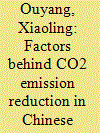

|
|
|
|
|
| Summary/Abstract |
As the most energy intensive industries, heavy industries are decisive for the realization of energy saving and emission reduction commitments. This study investigates factors behind CO2 emissions mitigation in China's heavy industries based on the system generalized method of moments (SYS-GMM) model. Results indicate that industrial structure (IS), fixed asset investment (F) and historical emissions are drivers for sectoral CO2 emission increase, while energy efficiency (EE) is a key factor for carbon emissions reduction. In order to further explore the effect of environmental regulations, we treat 2011 mandatory emission trading scheme (ETS) in high energy-consuming industries as a quasi-natural experiment, and conduct a Propensity Score Matching and Difference-in-Difference (PSM-DID) approach to analyze the policy effect. We find that the implementation of the mandatory emission reduction policy can reduce CO2 emissions of heavy industries, and the results are robust by testing the randomness of the policies. The policy implications are put forward to optimizing industrial structure and enhancing the environmental regulations in China's heavy industries.
|
|
|
|
|
|
|
|
|
|
|
|
|
|
|
|
| 3 |
ID:
176694
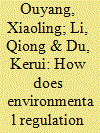

|
|
|
|
|
| Summary/Abstract |
Promoting technological innovations by environmental regulation is one of the essential means to achieve green transformation. This study investigates the effect of environmental regulation on technological innovations based on the provincial panel data of industrial sectors in China during the years 2005–2015. The two-way fixed-effect panel data model is used to investigate the marginal and heterogeneous impacts empirically. Results indicate a U-shaped relationship between environmental regulation and technological innovations. In the short-term, environmental regulation has an “offsetting effect” on the research and innovation capacity of China's industrial sector. However, with the deepening of environmental regulation, it forces the industry to reduce the cost of pollution control by improving technological innovation capacity, thus creating a “compensation effect”. Results also show that environmental regulation policies changed the location and industry selection of foreign capital, which weakened the positive effect of FDI on technological innovations, indicating the “pollution shelter” effect. From the perspective of different types of enterprises, due to the higher cost of energy conservation and emission reduction, environmental regulation is detrimental to the technological innovations of state-owned enterprises. In particular, we find that industries with a higher degree of market competition and higher human capital investment tend to have stronger technological innovation capabilities.
|
|
|
|
|
|
|
|
|
|
|
|
|
|
|
|
| 4 |
ID:
187601
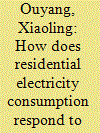

|
|
|
|
|
| Summary/Abstract |
Energy conservation from efficiency-oriented policies could be undermined due to the substitution effect and the income effect originating from the fact that energy efficiency improvement decreases the real price of electricity consumption. The ratio of the electricity consumption caused by the substitution effect and the income effect to the potential energy savings is termed the rebound effect. The magnitude of the rebound effect depicts how residential electricity consumption responds to electricity efficiency improvement. This paper adopts a stochastic electricity demand frontier approach based on the panel data covering 278 cities in China to uncover the relationship between electricity efficiency and residential electricity consumption. The main results show that 48.88% of the energy saving from efficiency improvement is offset due to households’ behavior adjustments. We also find that residential income, population density, and temperature deviation are vital determinants of residential electricity consumption, whereas household size significantly shapes the magnitude of the rebound effect. The empirical findings imply that different regions in China should design supporting policies for energy efficiency improvement according to local conditions considering that households are incentivized to consume more electricity with efficiency improvement.
|
|
|
|
|
|
|
|
|
|
|
|
|
|
|
|
| 5 |
ID:
132748
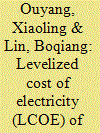

|
|
|
|
|
| Publication |
2014.
|
| Summary/Abstract |
The development and utilization of renewable energy (RE), a strategic choice for energy structural adjustment, is an important measure of carbon emissions reduction in China. High cost is a main restriction element for large-scale development of RE, and accurate cost estimation of renewable power generation is urgently necessary. This is the first systemic study on the levelized cost of electricity (LCOE) of RE in China. Results indicate that feed-in-tariff (FIT) of RE should be improved and dynamically adjusted based on the LCOE to provide a better support of the development of RE. The current FIT in China can only cover the LCOE of wind (onshore) and solar photovoltaic energy (PV) at a discount rate of 5%. Subsidies to renewables-based electricity generation, except biomass energy, still need to be increased at higher discount rates. Main conclusions are drawn as follows: (1) Government policy should focus on solving the financing problem of RE projects because fixed capital investment exerts considerable influence over the LCOE; and (2) the problem of high cost could be solved by providing subsidies in the short term and more importantly, by reforming electricity price in the mid-and long-term to make the RE competitive.
|
|
|
|
|
|
|
|
|
|
|
|
|
|
|
|
| 6 |
ID:
150375
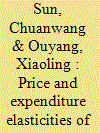

|
|
|
|
|
| Summary/Abstract |
Urbanization, one of the most obvious characteristics of economic growth in China, has an apparent “lock-in effect” on residential energy consumption pattern. It is expected that residential sector would become a major force that drives China's energy consumption after urbanization process. We estimate price and expenditure elasticities of residential energy demand using data from China's Residential Energy Consumption Survey (CRECS) that covers households at different income levels and from different regional and social groups. Empirical results from the Almost Ideal Demand System model are in accordance with the basic expectations: the demands for electricity, natural gas and transport fuels are inelastic in the residential sector due to the unreasonable pricing mechanism. We further investigate the sensitivities of different income groups to prices of the three types of energy. Policy simulations indicate that rationalizing energy pricing mechanism is an important guarantee for energy sustainable development during urbanization. Finally, we put forward suggestions on energy pricing reform in the residential sector based on characteristics of China's undergoing urbanization process and the current energy consumption situations.
|
|
|
|
|
|
|
|
|
|
|
|
|
|
|
|
|
|
|
|
|